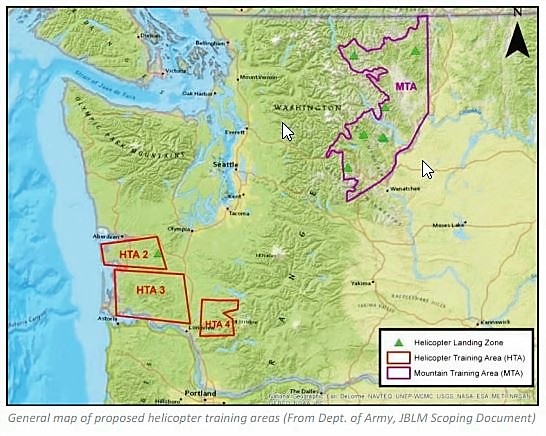By Bob Sextro, National Forest Committee and Chair, North Olympic Group
The U.S. Army’s Aviation Division at Joint Base Lewis-McChord (JBLM) announced its intent to establish off-base helicopter training and landing areas in the state of Washington.
The potential impact
Broadly speaking, these new training and landing areas would be located in the North Cascades backcountry of the Okanogan-Wenatchee National Forest and in a large area of southwest Washington on the doorstep of Mount St. Helens National Volcanic Monument.
According to the Army, these off-base training areas, once established, “would be available for use day and night, 24 hours a day, 365 days a year, with the exception of Federal holidays.”
Further, the Army estimates that “each helicopter training landing session of up to 4 hours in duration would involve as many as 7 helicopters performing 10–20 landings.”
 Sierra Club response
Sierra Club response
During the initial public comment period, the chapter’s National Forest (NF) Committee, submitted extensive comments to the Army at JBLM and also signed (along with 64 other conservation, recreation and wildlife organizations) a coordinated set of comments initiated by Washington Wild.
Chief among the many concerns with the Army’s proposed plans are the following:
- Failure of the Army to recognize the 1964 Federal Wilderness Act as a key law governing their use of proposed training and landing areas
- Several of the proposed training and landing areas in the Okanogan-Wenatchee National Forest are located in designated wilderness (i.e., Alpine Lakes), where landing of aircraft is prohibited
- Army has scoped to prepare an Environmental Assessment (EA), which generally leads to a finding of no significant impact, which is not appropriate, given the complexity and controversial nature of their proposal
- Several of the proposed training and landing areas in both the Okanogan-Wenatchee National Forest and in SW Washington are located in or near habitat for threatened and endangered species; designated natural resource conservation areas; or popular hiking and camping areas
The coordinated comment letter expresses support for our military to be well trained and ready to defend our country. However, it states that the Army should be able to achieve their goals without threatening our country’s investments in conservation, recreational opportunities and preservation of wildlife habitat.
Next steps
The Army closed the public comment period for the scoping phase in November 2015, and their next steps will likely include review and analysis of all public comments and the drafting of either an EA (as the Army has scoped) or an environmental impact statement (as Sierra Club has requested).
Once the draft document has been issued in 2016, the public will be notified and a public review period will start. During this public review period, the Army must also schedule and hold public meetings before the comment period ends.
The NF Committee will be ready to engage in reviewing the draft document once the review period begins, so stay tuned for future news in The Crest and/or the Chapter’s website.
For more information about this issue, please contact Bob Sextro by email.